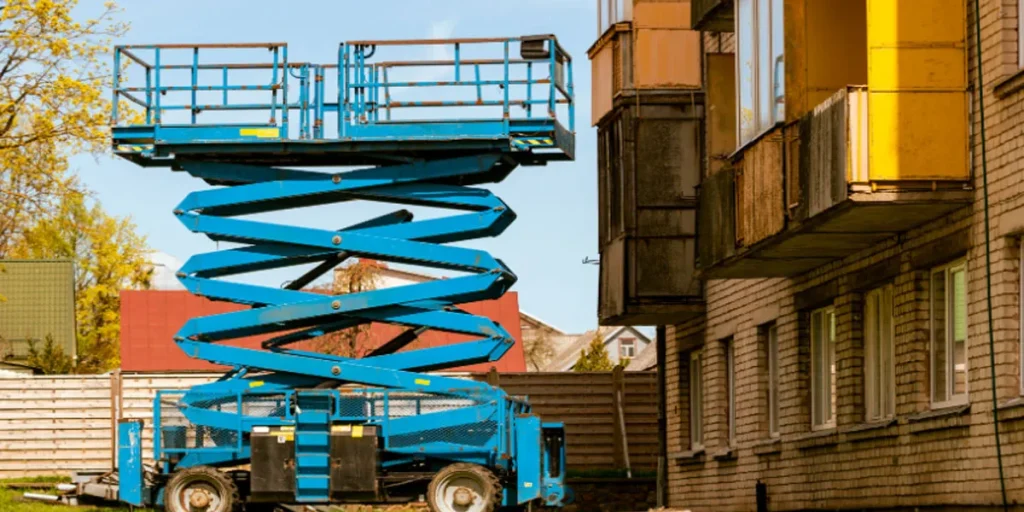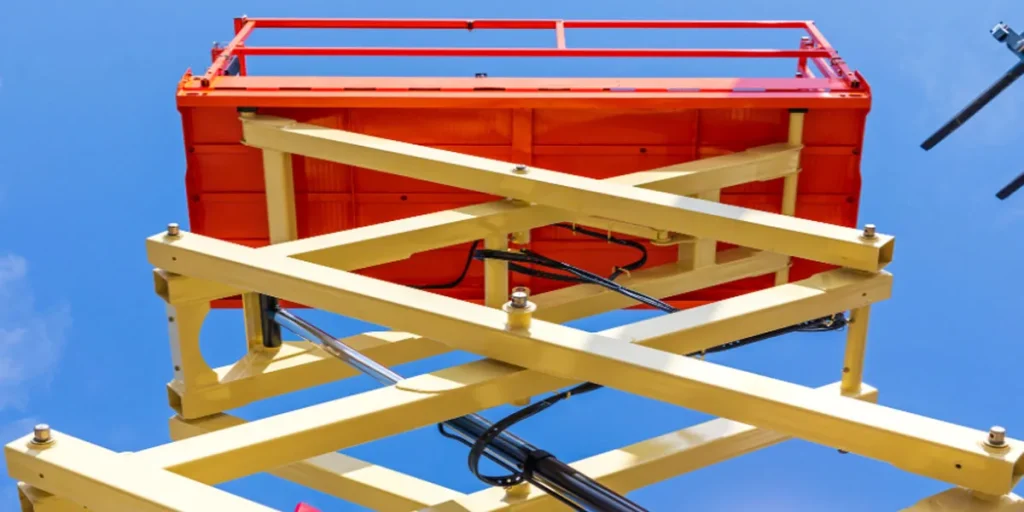A scissor lift typically weighs between 1,000 to 15,000 pounds (450 to 6,800 kilograms). The weight varies based on the size and model of the scissor lift.
Scissor lifts are versatile mobile platforms used primarily for elevating workers, tools, and materials to specific heights for maintenance, construction, and warehouse tasks.
Known for their crisscrossing metal supports that extend and compress like scissors, these machines come in various configurations to suit different environments and job requirements.
Electric scissor lifts tend to be on the lighter end of the spectrum, suitable for indoor use and on sensitive floors, while rough terrain models are heavier due to their stronger build and additional features meant for outdoor stability.
Manufacturers design each model to provide a reliable, steady platform that can safely hoist supplies and personnel, contributing to their differing weights.
The capacity, height reach, and integrated features all factor into a scissor lift’s weight, which must be considered when planning transportation and assessing job site limitations.

Role Of Scissor Lifts In Material Handling
Understanding the weight of a scissor lift is essential in the realm of material handling.
These powerful machines play a critical role in lifting and positioning heavy loads in warehouses, construction sites, and many industrial environments.
Efficiency and safety depend on selecting the appropriate scissor lift according to its weight and load capacity.
Key Functions Of Scissor Lifts
Scissor lifts are known for their versatility and are vital for numerous tasks:
- Moving Materials: They easily transport goods between different heights.
- Positioning Tasks: Workers position items accurately for further processes.
- Work Platforms: They provide stable platforms for carrying out overhead tasks.
- Load Capacities: These lifts come with varying load capacities to handle different weights safely.
Industries Relying On Scissor Lifts
Chosen for their reliability, scissor lifts contribute to operations across multiple sectors:
| Industry | Use Case |
|---|---|
| Construction | Elevating workers and materials to high points. |
| Retail Warehouses | Stock management and shelf stocking. |
| Manufacturing Plants | Component assembly and equipment maintenance. |
| Automotive Industry | Vehicle repair and parts assembly. |
Weight Ranges Of Scissor Lifts

Scissor lifts come in many shapes and sizes. Their weights vary. Different jobs need different scissor lifts.
Some are light and easy to move. Others are heavy and powerful. Let’s explore how much they weigh.
Comparing Small, Medium, And Large Models
Scissor lifts can be small, medium, or large. Their weight changes with size. Small ones are easy to use in tight spaces.
Medium ones balance size and strength. Large ones can reach high and carry more. Each has a different weight.
- Small models: Good for indoor work, light and compact.
- Medium models: Used for indoor and outdoor, more features.
- Large models: Best for outdoor projects, biggest and heaviest.
Typical Weights For Common Scissor Lift Sizes
Each scissor lift size has a usual weight. Here’s a quick look at common sizes:
| Size | Weight Range |
|---|---|
| Small | Less than 2,500 lbs |
| Medium | 2,500 to 5,000 lbs |
| Large | More than 5,000 lbs |
These weights help pick the right scissor lift. Proper selection ensures safety and efficiency.
Factors Influencing Scissor Lift Weight
Understanding the weight of a scissor lift is crucial for safety and operation. Several factors can influence this.
Knowing these factors helps you choose the right model for a job. Let’s explore the elements that add pounds to these vital pieces of equipment.
Material Construction And Durability
The material used to build a scissor lift plays a key role in its overall weight. Most scissor lifts have steel components.
However, the type of steel and its thickness can vary greatly. High-strength steel provides durability but adds extra weight.
The lift’s size also impacts its mass. Larger platforms designed for more workers naturally weigh more. This ensures the lift remains stable when at full height.
Impact Of Added Features And Accessories
Lifts aren’t just bare frames; they often come with useful additions. Extras such as extendable platforms, guardrails, and control panels can increase weight.
Additionally, performance features like four-wheel drive can add significant heft due to heavier components needed. Power sources matter, too. Electric batteries are heavier than propane tanks.
Let’s break down these factors:
- Base Material:
- Heavy-duty steel adds more weight than aluminum.
- Thickness and type of steel used can increase lift mass.
- Size and Load Capacity:
- Larger work platforms are heavier.
- Added support structures for more workers add weight.
- Features and Power Source:
- Extra features like extendable platforms make lifts heavier.
- Battery-powered lifts weigh more due to battery packs.
Scissor Lift Capacity Versus Weight

When choosing a scissor lift for a job, understanding the difference between the machine’s capacity and its own weight is crucial.
Both play a role in safety and performance. Let’s explore these vital aspects.
Understanding Load Limits
The load capacity of a scissor lift indicates how much weight it can safely lift. This capacity varies across models.
Manufacturers provide this information to ensure users can match their needs to the lift’s abilities.
Lift capacities typically range from 500 lbs to over 1,000 lbs. Here are key points to remember:
- Check the nameplate or manual for specific lift capacity.
- Distribute weight evenly on the platform.
- Exceeding load limits can be dangerous.
Safe Operation Relative To Lift Weight And Capacity
The weight of a scissor lift includes the structure, motor, and other components. It’s separate from the load limit. Operators must understand both for safe use.
Here are practices to ensure safety:
- Stay within the specified weight limit.
- Account for total weight, including tools and materials.
- Be cautious of ground conditions; softer soil may require a lighter lift.
Machine weights can vary widely, usually between 1,000 lbs and over 15,000 lbs. Here’s how they compare:
| Scissor Lift Model | Machine Weight | Load Capacity |
|---|---|---|
| Compact Electric | 1,500 lbs | 500 lbs |
| Rough Terrain | 7,000 lbs | 1,500 lbs |
| Large Electric | 15,000 lbs | 1,200 lbs |
Use the table to compare different scissor lifts. Choose one that best suits the job at hand. Lifts heavier than their capacity might be more stable but harder to maneuver.
Remember, safety is key. Understanding a scissor lift’s weight and capacity ensures the right choice for effective and secure operation.
Transportation And Installation Considerations
Understanding the weight of a scissor lift is vital. It affects how a crew moves and sets up the machine.
Logistics Of Moving Heavy Scissor Lifts
Scissor lifts can be heavy, with some weighing several thousand pounds. Proper planning is essential to move them safely. Here are key steps for transport:
- Select appropriate transport vehicles that can handle the lift’s weight and dimensions.
- Check route clearance and weight restrictions to ensure a smooth journey.
- Use specialized equipment, like cranes or forklifts, for loading and unloading.
- Secure the lift with straps and braces to prevent movement during transit.
Installation Implications For Weighty Machines
Heavy scissor lifts require stable ground conditions and support for setup. Take these considerations into account:
- Analyze site conditions to confirm the ground can support the lift’s weight.
- Prepare any necessary base reinforcements ahead of time.
- Strategize lift placement for optimal functionality and safety.
- Test all safety features once the lift is in position.
Future Developments In Scissor Lift Technology
The realm of construction and maintenance is buzzing with excitement. As we journey into the future, scissor lift technology leaps forward.
No longer are they the clunky and cumbersome machines of yesteryear. Today, they embody sleek innovation and trailblazing advancements that promise to revolutionize how we work at heights.
Advances In Weight Reduction
Industry engineers are spearheading efforts to make scissor lifts lighter.
By incorporating high-strength materials and ingenious design modifications, new models are shedding pounds while maintaining their robust performance.
Here’s a glimpse of what’s unfolding:
- Aluminum and composite materials replace traditional steel
- Redesigned structures that maintain integrity at reduced weights
- Components optimized through computer-aided engineering
Impact On Efficiency And Safety
With weight reduction, the future of scissor lifts glows bright. Lighter scissor lifts translate directly to enhanced job site efficiency and better safety. Key areas of impact include:
| Efficiency | Safety |
|---|---|
| Easier to maneuver | Lower risk of tip-over |
| Less wear on components | Reduced operator fatigue |
| Faster deployment | Enhanced control systems |
FAQs About the Weight of a Scissor Lift
What Is The Average Weight Of A Scissor Lift?
Scissor lifts vary in weight depending on size and capacity. However, a typical scissor lift can weigh between 1,000 to 15,000 pounds.
Smaller, push-around lifts are on the lighter end, while larger, rough-terrain lifts weigh more.
How Do Weight Limits Impact Scissor Lift Operation?
The weight limit of a scissor lift affects its operational safety and capability. Overloading can risk collapse or malfunction.
Always check the manufacturer’s specifications for maximum safe working load before use, which is typically ranging from 500 to 1,000 pounds.
Can The Weight Of A Scissor Lift Affect Transportation?
Yes, the weight of a scissor lift certainly impacts transportation. Heavier lifts require suitable transport vehicles and may necessitate additional permits or licenses due to their weight class. Plan logistics accordingly to ensure safe and legal transport.
Are Electric Scissor Lifts Lighter Than Diesel Ones?
Electric scissor lifts are generally lighter than diesel-powered variants. This is because electric lifts have a smaller engine and do not require a fuel storage system.
Electric models are well-suited for indoor use where lighter weight and less noise are advantageous.
Conclusion
Understanding the weight of a scissor lift is crucial for safety and efficiency. Each model varies, with a range typically between 1,500 to 15,000 pounds.
Always consult the manufacturer’s specifications for accurate information. Selecting the right lift for your task ensures a secure and productive work environment.
Remember to consider weight limits and operational requirements for optimal use.
Resources:
https://www.osha.gov/etools/scaffolding/scissor-lifts
https://www.in.gov/dol/iosha/worker-safety-initiatives/scissor-lifts/
